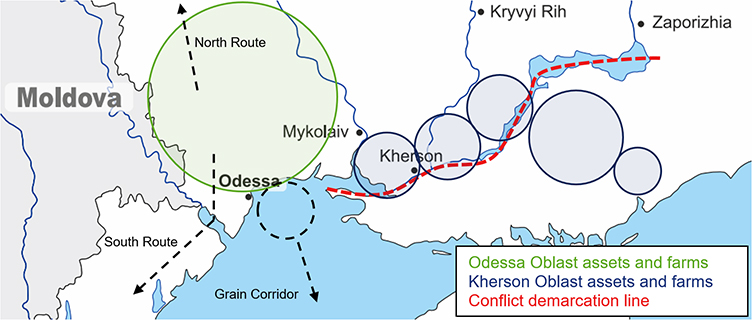Ukraine, Russia and trade finance
Ukraine has long been recognised as one of the largest producers of grain in the world. Its fertile land and favourable climate make it an agricultural powerhouse, contributing significantly to the world’s food supply. According to the European Commission, Ukraine accounts for 10% of the global wheat market, 15% of the corn market and 13% of the barley market. It is also a key global player in the sunflower oil market. As of today, with the Black Sea Grain Corridor agreement not being extended by Russia, trade finance managers find themselves at a crossroads.
The impact of the conflict on trade finance: trouble ahead?
The Russian invasion of Ukraine in February 2022 has had a significant impact on trade finance. The war has disrupted trade flows and created uncertainty for businesses operating in the region. The fighting has caused serious damage to infrastructure, including ports, airports and roads, making it difficult for businesses to transport goods and materials across the country and abroad. This has led to delays in shipments and a significant increase in storage, processing and transport costs, amongst other things.
The war in Ukraine has served as a wake-up call for trade finance managers, highlighting the need for enhanced resilience and contingency planning. Diversifying funding sources and building strong relationships with local stakeholders are vital aspects for their survival.
Ukraine’s agricultural regions, focusing on the Kherson and Odessa Oblasts
The Russian invasion has left a significant imprint on Ukraine’s economic landscape, especially in relation to the production of goods and functioning of supply chains. The magnitude of this impact differs across regions, largely influenced by the geographical proximity to the frontline or occupied territories. Soft commodities are a striking example. Known as the breadbasket of Europe, Ukraine is a country blessed with agricultural diversity and trading capabilities across regions. The Odessa and Kherson Oblasts are the two main regions in Ukraine for soft commodities.
The Kherson Oblast, situated in southern Ukraine, benefits from fertile soil and a favourable climate. It is a significant agricultural region, specialising in the production of grain such as wheat, barley and corn. The vast fields of the Kherson Oblast also yield oilseed crops such as sunflowers and soybeans, as well as a variety of fruit and vegetables. Meanwhile, Odessa Oblast, located along the Black Sea coast, thrives as a major transportation and trading hub. The region’s ports, including the renowned port of Odessa, facilitate the export of commodities not only from Odessa itself but also from other regions. Odessa Oblast is known for its grain production, particularly wheat, barley and corn. Additionally, the cultivation of oilseed crops and a wide range of agricultural products like sugar beet, potatoes and fruit contribute to its economic vitality.
Trade finance firms have managed to maintain control over their underlying assets in the Odessa Oblast, which has remained under Ukrainian control since the start of the war. However, owing to the conflict’s demarcation line, farming clusters in the Kherson Oblast had to be left dormant after the 2022 winter crop harvest. Non-resident personnel were repatriated and movable materials were relocated to other oblasts such as the Odessa Oblast. Since November 2022, companies have managed to bring back some farming clusters above the demarcation line, with demining operations underway. However, crop operations in the area still face uncertainty because of its military zone status and military control.
The winter crops planted in the fourth quarter of 2022 have shown promise, benefiting from favourable weather conditions. Satellite measurements in the south indicate that yields are 20-25% above the long-term average. Export processes are underway, targeting completion by the fourth quarter of 2023. As for the spring crops, approximately 50% of planting was completed within acceptable timeframes, despite some delays caused by prolonged wet spells.
Some local counterparties managed to successfully export their production through the Black Sea Grain Corridor. However, other counterparties located in the middle of the Odessa Oblast faced logistical challenges due to limited export options. Land corridors and river ports were used but proved less efficient than the Black Sea Grain Corridor. Additionally, foreign exchange control required payments in US dollars on local collection accounts, leading to delays in obtaining repatriation of funds.

Russia suspends Black Sea Grain Initiative: what happens next?
The anticipated worst-case scenarios regarding food prices and security which were expected at the beginning of the war have not yet materialised. Instead, the initial impact has been contained, partly thanks to the openness of the multilateral trading system and the transparency and commitments it requires from its members. This demonstrates that promoting deeper and diverse international markets based on open and predictable trade rules ultimately enhances resilience.
However, as this blog article was being written, Russia decided that it would not renew the landmark Ukraine grain deal. Signed in July 2022, the Black Sea Grain Initiative, brokered by the United Nations, has been repeatedly extended in short increments. The deal permitted the export of grain from three Ukrainian Black Sea ports (Odessa, Chornomorsk and Pivdennyi, formerly known as Yuzhny) with the assurance of safe passage for ships entering and leaving these ports.
With the absence of the grain pact, Ukraine will now be compelled to export the majority of its grain and oilseed via its land borders and Danube ports. This will considerably increase transportation costs and put additional pressure on the profitability of Ukrainian farmers. As a result, farmers may choose to plant fewer crops next season, placing further pressure on supplies going forward.
The future? A mixed cauldron of optimism, hope and a pinch of uncertainty
Despite the uncertainty surrounding the Black Sea corridor and import bans, trade finance companies are working diligently to navigate the complexities and maintain control over their assets. While challenges persist, the dedication of managers and the favourable crop conditions provide hope for a successful harvest and positive outcomes for grain transactions in the near future. Nevertheless, Russia’s unpredictability looms as a significant factor at play that cannot be ignored.



